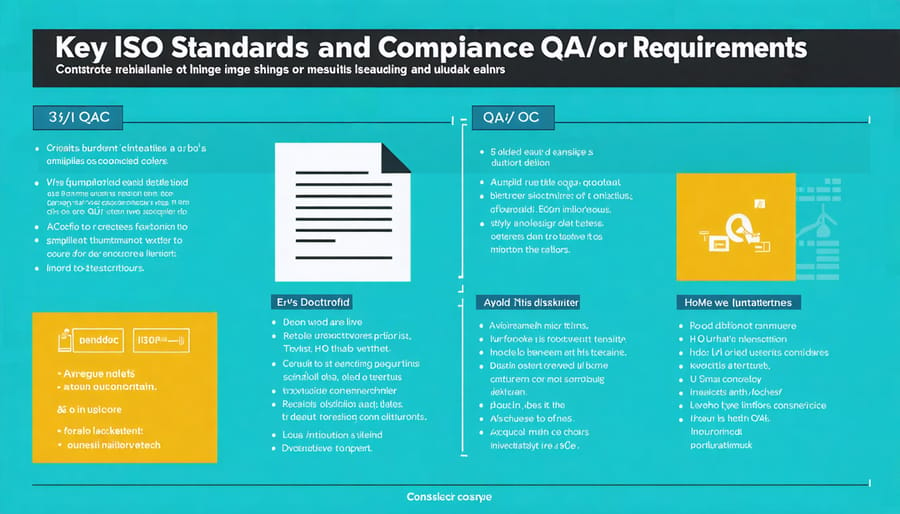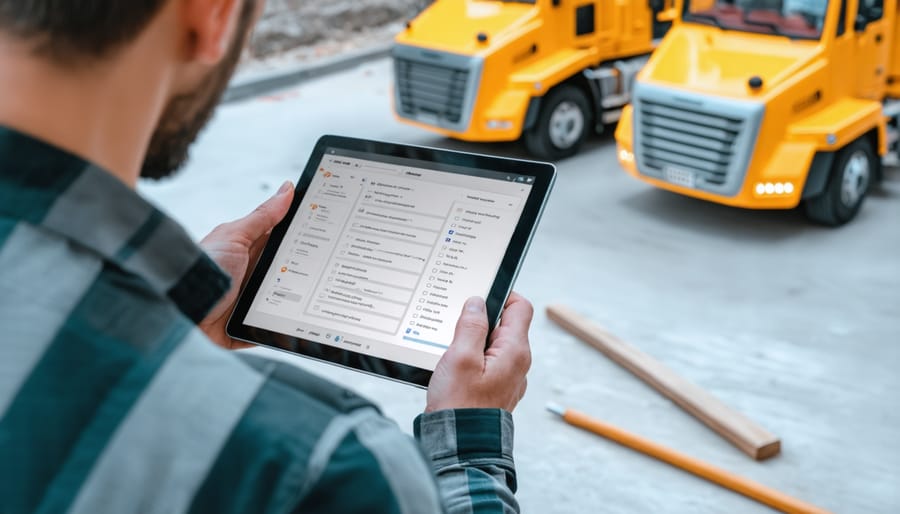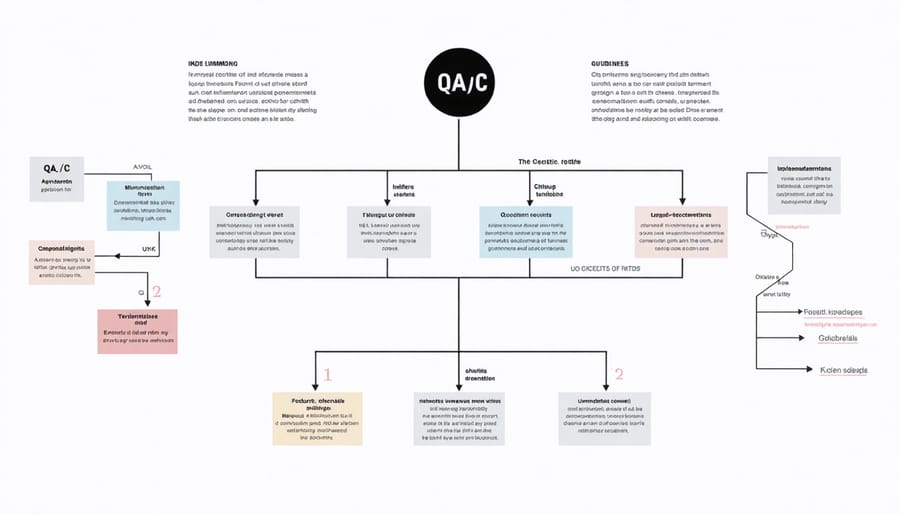Quality Assurance and Quality Control (QA/QC) processes form the backbone of successful construction project delivery, driving compliance with construction quality standards while minimizing costly rework and delays. In today’s complex building environment, where project stakes are higher than ever, implementing robust QA/QC protocols has evolved from a best practice to an absolute necessity. Recent industry data reveals that projects with comprehensive quality management systems experience 25% fewer defects and achieve 30% better cost performance compared to those without structured QA/QC programs.
The integration of digital quality management platforms, real-time documentation systems, and advanced inspection technologies has revolutionized how construction teams approach quality control. These innovations, combined with traditional oversight methods, create a multi-layered defense against construction defects while ensuring regulatory compliance across all project phases. For industry professionals navigating increasingly stringent regulatory requirements and rising client expectations, mastering QA/QC principles and practices has become fundamental to maintaining competitive advantage and delivering exceptional project outcomes.
This comprehensive guide examines cutting-edge QA/QC methodologies, regulatory frameworks, and practical implementation strategies that enable construction teams to achieve superior quality results while maintaining project efficiency and profitability.
Regulatory Framework for Construction QA/QC
International Standards and Compliance
International construction projects must adhere to various ISO standards and building codes that govern quality assurance and quality control processes. ISO 9001:2015 serves as the foundational framework for quality management systems in construction, establishing requirements for documentation, process control, and continuous improvement.
Key international standards affecting construction QA/QC include ISO 45001 for occupational health and safety, ISO 14001 for environmental management, and ISO 19011 for auditing management systems. These standards work in conjunction to ensure comprehensive quality control across all aspects of construction projects.
The International Building Code (IBC) provides minimum requirements for building systems, while regional codes like the Eurocodes in Europe and the National Building Code in various countries add specific local requirements. Construction firms must navigate these overlapping requirements while maintaining consistent quality standards across international projects.
Compliance documentation typically requires:
– Quality management system certification
– Material testing reports
– Inspection records
– Non-conformance reports
– Corrective action documentation
– Third-party verification certificates
Modern construction projects increasingly rely on digital documentation systems to demonstrate compliance with these standards. Cloud-based quality management platforms enable real-time tracking of compliance metrics and facilitate international collaboration while ensuring adherence to relevant standards across different jurisdictions.
To maintain international compliance, organizations must regularly update their QA/QC procedures as standards evolve and new requirements emerge. This includes staff training, documentation updates, and periodic system audits to verify continued compliance.

Local Building Codes and Requirements
Local jurisdictions play a crucial role in establishing and enforcing building code requirements that directly impact QA/QC processes. These regulations vary significantly by region and municipality, requiring construction teams to maintain detailed knowledge of local standards and their specific applications.
Construction quality management must align with International Building Code (IBC) provisions as adopted by local authorities, while also incorporating state-specific amendments and municipal overlays. This creates a complex regulatory framework that demands careful attention to detail and thorough documentation throughout the construction process.
Key aspects of local code compliance include structural safety requirements, fire protection standards, accessibility guidelines, and environmental considerations. QA/QC managers must ensure that inspection protocols address each of these elements while maintaining compliance with both general and jurisdiction-specific requirements.
Regular updates to local building codes necessitate continuous education and adaptation of QA/QC procedures. Successful implementation requires:
– Maintaining current knowledge of local code amendments
– Establishing relationships with local building officials
– Developing inspection checklists that reflect regional requirements
– Training staff on jurisdiction-specific compliance matters
– Creating documentation systems that satisfy local authority requirements
Understanding and implementing these local requirements is fundamental to achieving project success and avoiding costly delays or corrections during construction.
Essential Components of Construction QA/QC Programs
Documentation and Record-Keeping Systems
Modern construction projects demand robust documentation and record-keeping systems to ensure quality control and regulatory compliance. Digital document management systems (DMS) have largely replaced traditional paper-based methods, offering real-time access, enhanced security, and improved collaboration capabilities.
These systems typically incorporate several key components: quality control inspection reports, material testing certificates, non-conformance reports, corrective action documentation, and equipment calibration records. Cloud-based platforms enable stakeholders to access, update, and share documents instantly across multiple project sites while maintaining version control and audit trails.
Construction firms increasingly utilize mobile applications for on-site documentation, allowing field personnel to complete inspections, capture photos, and generate reports directly from their devices. These apps often integrate with project management software, creating a seamless flow of information between field operations and office management.
Quality management systems (QMS) should maintain records for a minimum of seven years, though some jurisdictions require longer retention periods. Electronic documentation systems must incorporate robust security measures, including encrypted storage, regular backups, and controlled access protocols.
To ensure effectiveness, documentation systems should follow a standardized format that includes date stamps, responsible parties, verification signatures, and clear reference numbers. This systematic approach facilitates easy retrieval during audits and helps demonstrate compliance with project specifications and regulatory requirements. Regular system audits and updates ensure the documentation process remains current with evolving industry standards and project needs.
Inspection Protocols and Verification Methods
Effective inspection protocols in construction QA/QC follow a systematic, three-phase approach: preparatory, initial, and follow-up inspections. During the preparatory phase, teams review project specifications, drawings, and relevant standards while ensuring all prerequisites are met before work begins.
Initial inspections occur at the start of each new phase or work segment, establishing baseline quality standards and verifying proper execution of construction methods. Follow-up inspections maintain consistency throughout the project lifecycle, with frequency determined by risk assessment and project complexity.
Verification methods include both destructive and non-destructive testing, depending on the element being evaluated. Common techniques involve concrete strength testing, welding inspections, soil compaction tests, and dimensional verification. Documentation through detailed checklists, photographs, and digital reporting tools ensures transparency and traceability.
Hold points and witness points are crucial elements of modern inspection protocols. Hold points require mandatory inspection and approval before work can proceed, while witness points allow work to continue after notification, even if the inspection hasn’t occurred.
Quality verification increasingly incorporates technology such as 3D scanning, drone surveys, and real-time monitoring systems. These tools enhance accuracy and efficiency while providing detailed documentation for compliance purposes. Regular calibration of testing equipment and continuous training of inspection personnel remain fundamental to maintaining inspection integrity.
Daily inspection reports must include date, location, work activities, weather conditions, test results, and any non-conformance issues identified, creating a comprehensive record for project documentation and potential dispute resolution.

Testing Requirements and Standards
Construction testing requirements and compliance with established safety standards form the backbone of effective QA/QC programs. Key testing procedures typically include concrete strength testing, soil compaction analysis, welding inspections, and materials verification. These tests must align with standards set by organizations such as ASTM International, ISO, and regional building codes.
Essential testing requirements encompass both destructive and non-destructive methods. Non-destructive testing (NDT) includes ultrasonic testing, radiographic inspection, and magnetic particle testing, which evaluate structural integrity without compromising the materials. Destructive testing involves examining samples to failure points, providing crucial data about material performance under stress.
Industry standards mandate specific testing frequencies, methodologies, and documentation requirements. For concrete work, compression testing must occur at designated intervals, typically at 7 and 28 days after placement. Soil testing requires verification of compaction levels at predetermined depths and locations throughout the construction site.
Documentation plays a crucial role in testing compliance. Each test must be properly recorded, including date, location, methodology, results, and verification by qualified personnel. Modern QA/QC programs increasingly utilize digital documentation systems to ensure accuracy and accessibility of test results, enabling real-time tracking and analysis of construction quality metrics.
Technology Integration in QA/QC Processes
Digital Quality Management Systems
Modern construction projects increasingly rely on digital Quality Management Systems (QMS) to streamline QA/QC processes. These sophisticated platforms, which have seen substantial growth through recent construction technology investments, offer comprehensive solutions for documentation, inspection management, and real-time compliance monitoring.
Leading digital QMS platforms integrate features such as mobile inspection forms, automated workflow management, and cloud-based document control. These systems enable real-time data collection, instant report generation, and seamless communication between field teams and office personnel. Key functionalities typically include defect tracking, photo documentation, and automated notification systems for non-conformance issues.
Implementation of digital QMS has shown significant benefits, including a 45% reduction in documentation time and a 60% decrease in quality-related rework costs. These systems maintain detailed audit trails, ensuring transparency and accountability throughout the construction process. They also facilitate better collaboration between stakeholders by providing centralized access to quality-related information and standardized reporting templates.
When selecting a digital QMS, organizations should evaluate factors such as integration capabilities with existing software, mobile functionality, offline capabilities, and customization options. The system should also support regulatory compliance requirements and industry standards while remaining user-friendly for field personnel. Regular updates and reliable technical support are essential considerations for long-term success.

Mobile Inspection Tools and Applications
Mobile inspection tools and applications have revolutionized quality control processes in construction, enabling real-time documentation, collaboration, and issue resolution directly from the field. These digital solutions streamline traditional paper-based inspection methods while improving accuracy and communication between project stakeholders.
Leading construction inspection applications offer features such as customizable checklists, photo documentation with annotation capabilities, and GPS location tracking. Field teams can capture defects, track remediation progress, and generate comprehensive reports instantly, significantly reducing administrative overhead and potential documentation errors.
Cloud-based platforms enable immediate synchronization of field data with project management systems, allowing office teams to monitor quality control activities in real-time. Many applications integrate with Building Information Modeling (BIM) software, providing inspectors with detailed 3D models and specifications during field inspections.
Key functionalities often include:
– Digital punch lists with automated notification systems
– Issue tracking with status updates and assignment capabilities
– Document management for specifications and drawings
– Quality control metrics and analytics dashboards
– Mobile offline capabilities for areas with limited connectivity
– Electronic signature collection for approvals
The adoption of these tools has demonstrated measurable improvements in inspection efficiency, with some projects reporting up to 50% reduction in documentation time and significantly faster issue resolution cycles. When selecting mobile inspection tools, organizations should consider factors such as ease of use, integration capabilities with existing systems, and scalability across multiple projects.
Implementation Strategies and Challenges
Staff Training and Certification Requirements
Effective QA/QC implementation in construction relies heavily on well-trained personnel who understand both technical requirements and OSHA compliance requirements. Key staff members must possess relevant certifications and undergo regular training to maintain high quality standards throughout construction projects.
Quality control inspectors typically require a minimum of a bachelor’s degree in construction management, engineering, or related fields, complemented by industry-specific certifications. Essential certifications include the Certified Construction Quality Control Manager (CQCM) credential from the American Society for Quality (ASQ) and the Quality Control Management Certificate Program (QCMP) from the Associated General Contractors of America (AGC).
Training programs should cover inspection methodologies, documentation procedures, testing protocols, and regulatory compliance. Staff must demonstrate proficiency in using quality control tools, understanding specifications, and interpreting construction drawings. Regular updates through continuing education ensure teams stay current with evolving industry standards and technological advances.
Project managers and supervisors should complete additional certifications in project quality management and maintain professional development units (PDUs) to retain their credentials. On-site training programs, mentorship opportunities, and hands-on experience are crucial components of a comprehensive QA/QC training strategy, ensuring practical application of theoretical knowledge in real-world construction scenarios.
Cost Management and Resource Allocation
Effective QA/QC implementation requires careful consideration of both financial resources and personnel allocation. Industry data suggests that quality management typically accounts for 2-5% of total project costs, though this investment often results in significant savings through reduced rework and improved project outcomes.
Budget allocation for QA/QC should encompass several key components: staffing costs for dedicated quality personnel, testing equipment and calibration, third-party inspections, documentation systems, and training programs. Organizations must also factor in costs associated with quality-related software, certification maintenance, and periodic system audits.
Resource planning should focus on both human capital and technical infrastructure. This includes hiring qualified quality managers, inspectors, and technicians, while also ensuring adequate testing facilities and equipment are available. Many successful construction firms implement a matrix organizational structure, where quality personnel report both to project management and a central quality department, optimizing resource utilization across multiple projects.
To maximize ROI, companies should adopt a risk-based approach to resource allocation. This involves identifying critical inspection points and high-risk activities that require enhanced oversight, while maintaining standard quality protocols for routine operations. Digital tools and automation can help optimize resource deployment by streamlining documentation and enabling real-time monitoring of quality metrics.
Regular cost-benefit analysis of QA/QC activities helps organizations refine their resource allocation strategy and identify areas for efficiency improvements while maintaining quality standards.

Common Pitfalls and Solutions
Construction QA/QC processes frequently encounter several critical challenges that can impact project quality and timeline. Documentation gaps remain one of the most prevalent issues, where inspection records are incomplete or improperly maintained. This can be addressed by implementing digital documentation systems with automated reminders and standardized forms.
Material non-conformance presents another significant challenge, often discovered too late in the construction process. Establishing robust receiving inspection protocols and maintaining detailed material tracking systems can prevent costly rework. Regular supplier evaluations and pre-qualification processes help ensure consistent material quality.
Communication breakdowns between field teams and quality personnel frequently lead to missed inspections or delayed corrective actions. Solutions include implementing daily quality briefings and utilizing mobile communication platforms that enable real-time issue reporting and resolution tracking.
Inadequate training of field personnel in quality procedures often results in oversight errors. Developing comprehensive training programs, including hands-on demonstrations and regular refresher courses, helps maintain consistent quality standards across the project.
Schedule pressure sometimes leads to compromised quality checks. This can be mitigated by incorporating quality milestones into project schedules and ensuring adequate resources are allocated for inspection activities. Having dedicated QA/QC personnel who report independently from production teams helps maintain objective quality oversight.
Resource constraints, particularly in smaller projects, can limit proper quality control implementation. Consider utilizing third-party inspection services for critical phases and implementing risk-based inspection approaches to optimize available resources while maintaining essential quality standards.
Quality Assurance and Quality Control in construction continue to evolve as cornerstones of successful project delivery, with their importance only growing as construction projects become more complex and stakeholder expectations increase. The integration of these systematic approaches has proven instrumental in reducing errors, improving safety standards, and ensuring project outcomes align with specifications and requirements.
As we’ve explored throughout this article, effective QA/QC programs encompass multiple critical elements: comprehensive documentation, rigorous inspection protocols, clear communication channels, and systematic testing procedures. The successful implementation of these elements relies heavily on both human expertise and technological solutions, creating a balanced approach that maximizes efficiency while maintaining high quality standards.
Looking ahead, the future of QA/QC in construction appears increasingly technology-driven. Artificial intelligence, machine learning, and IoT sensors are revolutionizing how quality control measures are implemented and monitored. These innovations, combined with traditional inspection methods, are creating more robust and reliable quality management systems.
However, the human element remains irreplaceable. The expertise of qualified inspectors, the judgment of experienced project managers, and the collaborative effort of all stakeholders continue to form the foundation of effective quality control programs. The key to future success lies in harmonizing technological advancement with human expertise.
For construction professionals moving forward, staying current with evolving QA/QC methodologies, regulatory requirements, and technological tools will be crucial. The industry’s commitment to continuous improvement in quality management practices will not only enhance project outcomes but also contribute to the overall advancement of construction standards and methodologies.
This dynamic landscape presents both challenges and opportunities, making it essential for organizations to maintain adaptable and forward-thinking approaches to quality management while building on established best practices.

